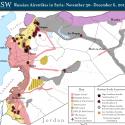 |
 |
Russian Airstrikes in Syria: November 30 - December 6, 2015
Dec 8, 2015 - Genevieve Casagrande


Russia resumed its air campaign in Southern Syria in support of regime ground operations against the FSA-affiliated Southern Front from December 3-6. Russia’s renewed effort follows a December 3 declaration by FSA-affiliated Southern Front factions, including tribal fighters who claim to receive funding from Jordan, of a new offensive to seize the regime-held Judayyah artillery battalion in the northwestern countryside of Dera’a province. Russian airstrikes targeted areas along the nearby frontline surrounding the battalion, an area primarily held by Southern Front-affiliated factions. The shift comes just two weeks after Russian President Vladimir Putin vowed to avoid hitting “healthy,” non-terrorist rebel groups in Syria and to focus air operations against ISIS. While talks between members of the Syrian opposition and the Syrian regime are tentatively scheduled for January 1, 2016, Russia’s continued aggression makes the prospects of a mutually agreeable political transition unlikely.
The Syrian Foreign Ministry accused the U.S.-led coalition of conducting an airstrike against a regime military position in the town of Ayyash in Deir ez-Zour province on December 6 killing four Syrian Arab Army (SAA) soldiers and wounding thirteen others. The ministry sent a letter to the U.N. Security Council in protest of “flagrant aggression by the U.S.-led coalition forces.” Operation Inherent Resolve Spokesman Colonel Steve Warren denied that the Coalition carried out the attack, stressing that the nearest coalition strikes targeted an ISIS-held oil field 35 miles away from the incident. Anonymous Pentagon officials stated that radar data indicated that the bombing had been a 'friendly fire' incident committed by a Russian bomber. Local sources have previously reported on alleged Russian strikes against regime positions along frontlines in both Homs and Latakia Provinces.
The following graphic depicts ISW’s assessment of Russian airstrike and cruise missile locations based on reports from local Syrian activist networks, Syrian state-run media, and statements by Russian and Western officials. This map represents locations targeted by Russia’s air campaign, rather than the number of individual strikes or sorties.
High-Confidence reporting. ISW places high confidence in reports corroborated both by official government statements reported through credible channels and documentation from rebel factions or activist networks on the ground in Syria deemed to be credible.
Low-Confidence reporting. ISW places low confidence in secondary sources that have not been confirmed or sources deemed likely to contain disinformation.